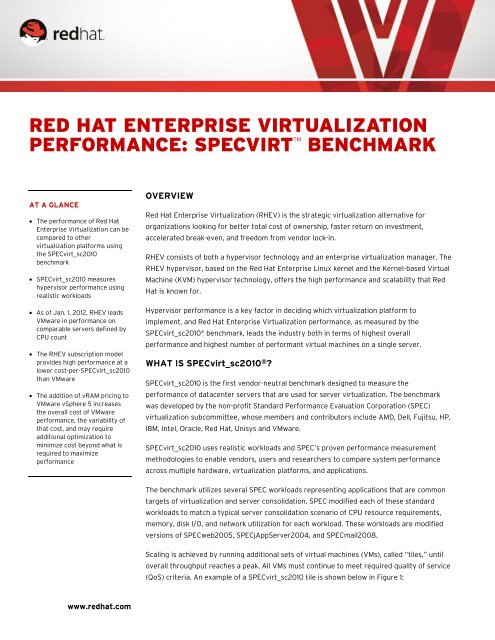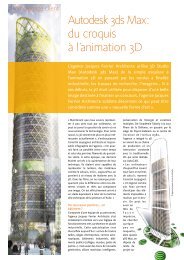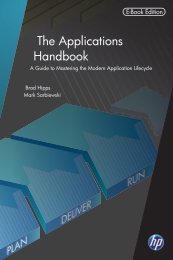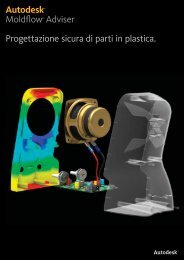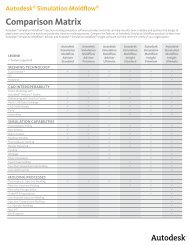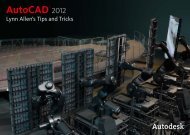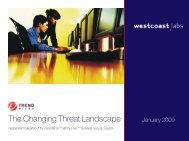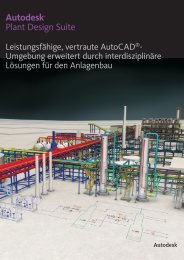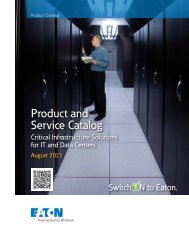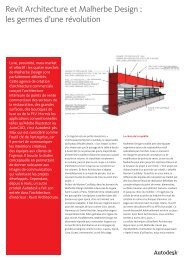red hat enterprise virtualization performance: specvirt ... - Zift Solutions
red hat enterprise virtualization performance: specvirt ... - Zift Solutions
red hat enterprise virtualization performance: specvirt ... - Zift Solutions
You also want an ePaper? Increase the reach of your titles
YUMPU automatically turns print PDFs into web optimized ePapers that Google loves.
RED HAT ENTERPRISE VIRTUALIZATION<br />
PERFORMANCE: SPECVIRT BENCHMARK<br />
AT A GLANCE<br />
• The <strong>performance</strong> of Red Hat<br />
Enterprise Virtualization can be<br />
compa<strong>red</strong> to other<br />
<strong>virtualization</strong> platforms using<br />
the SPECvirt_sc2010<br />
benchmark<br />
• SPECvirt_sc2010 measures<br />
hypervisor <strong>performance</strong> using<br />
realistic workloads<br />
• As of Jan. 1, 2012, RHEV leads<br />
VMware in <strong>performance</strong> on<br />
comparable servers defined by<br />
CPU count<br />
• The RHEV subscription model<br />
provides high <strong>performance</strong> at a<br />
lower cost-per-SPECvirt_sc2010<br />
than VMware<br />
• The addition of vRAM pricing to<br />
VMware vSphere 5 increases<br />
the overall cost of VMware<br />
<strong>performance</strong>, the variability of<br />
t<strong>hat</strong> cost, and may require<br />
additional optimization to<br />
minimize cost beyond w<strong>hat</strong> is<br />
requi<strong>red</strong> to maximize<br />
<strong>performance</strong><br />
OVERVIEW<br />
Red Hat Enterprise Virtualization (RHEV) is the strategic <strong>virtualization</strong> alternative for<br />
organizations looking for better total cost of ownership, faster return on investment,<br />
accelerated break-even, and freedom from vendor lock-in.<br />
RHEV consists of both a hypervisor technology and an <strong>enterprise</strong> <strong>virtualization</strong> manager. The<br />
RHEV hypervisor, based on the Red Hat Enterprise Linux kernel and the Kernel-based Virtual<br />
Machine (KVM) hypervisor technology, offers the high <strong>performance</strong> and scalability t<strong>hat</strong> Red<br />
Hat is known for.<br />
Hypervisor <strong>performance</strong> is a key factor in deciding which <strong>virtualization</strong> platform to<br />
implement, and Red Hat Enterprise Virtualization <strong>performance</strong>, as measu<strong>red</strong> by the<br />
SPECvirt_sc2010 ® benchmark, leads the industry both in terms of highest overall<br />
<strong>performance</strong> and highest number of performant virtual machines on a single server.<br />
WHAT IS SPECvirt_sc2010 ® ?<br />
SPECvirt_sc2010 is the first vendor-neutral benchmark designed to measure the<br />
<strong>performance</strong> of datacenter servers t<strong>hat</strong> are used for server <strong>virtualization</strong>. The benchmark<br />
was developed by the non-profit Standard Performance Evaluation Corporation (SPEC)<br />
<strong>virtualization</strong> subcommittee, whose members and contributors include AMD, Dell, Fujitsu, HP,<br />
IBM, Intel, Oracle, Red Hat, Unisys and VMware.<br />
SPECvirt_sc2010 uses realistic workloads and SPEC’s proven <strong>performance</strong> measurement<br />
methodologies to enable vendors, users and researchers to compare system <strong>performance</strong><br />
across multiple hardware, <strong>virtualization</strong> platforms, and applications.<br />
The benchmark utilizes several SPEC workloads representing applications t<strong>hat</strong> are common<br />
targets of <strong>virtualization</strong> and server consolidation. SPEC modified each of these standard<br />
workloads to match a typical server consolidation scenario of CPU resource requirements,<br />
memory, disk I/O, and network utilization for each workload. These workloads are modified<br />
versions of SPECweb2005, SPECjAppServer2004, and SPECmail2008.<br />
Scaling is achieved by running additional sets of virtual machines (VMs), called “tiles,” until<br />
overall throughput reaches a peak. All VMs must continue to meet requi<strong>red</strong> quality of service<br />
(QoS) criteria. An example of a SPECvirt_sc2010 tile is shown below in Figure 1:<br />
www.<strong>red</strong><strong>hat</strong>.com
Figure 1<br />
Scaling the workload on the tested system consists of running an increasing number of tiles.<br />
Peak <strong>performance</strong> is the point at which the addition of another tile (or fraction) either fails<br />
the QoS criteria or fails to improve the overall metric.<br />
HOW DOES RHEV PERFORM ON SPECvirt_sc2010 ® ?<br />
As of Jan. 1, 2012, 21 SPECvirt_sc2010 benchmark results have been published by<br />
organizations testing both Red Hat Enterprise Virtualization and VMware ESXi hypervisor<br />
platforms. All SPECvirt_sc2010 scores below are measu<strong>red</strong> as XXXX@YYY where XXXX is<br />
the raw <strong>performance</strong> score and YYY is the number of VMs t<strong>hat</strong> yielded t<strong>hat</strong> score.<br />
Performance per core and per CPU<br />
Below in Table 1, the best SPECvirt_sc2010 score for each category of core count is<br />
compa<strong>red</strong>. RHEV leads VMware in the 12, 20, and 40 core categories and has the only<br />
published 64 and 80 core scores.<br />
# of cores Best VMware SPECvirt_sc2010<br />
score<br />
Best RHEV SPECvirt_sc2010 score<br />
12 1221@78 1367@84<br />
16 1570@102* 1369@84<br />
20 1878@120 2144@132<br />
32 2742@168 N/A<br />
40 3824@234 4603@282<br />
64 N/A 5466@336<br />
80 N/A 8956@552<br />
Table 1 * The best “16 core” score for VMware is on a dual-socket AMD Opteron 6282 SE with 8 cores and 16<br />
integer units per CPU, compa<strong>red</strong> with the 8 cores and 8 integer units per CPU with the dual-socket<br />
Intel X7560 used for the best Red Hat score.<br />
www.<strong>red</strong><strong>hat</strong>.com
As shown in Table 2, RHEV also leads VMware in the two- and four-socket server category<br />
and has the only published scores for eight-socket servers, including the single server with<br />
the highest overall <strong>performance</strong> (8956) and the highest number of performant virtual<br />
machines (552 VMs).<br />
# of CPU Best VMware SPECvirt_sc2010<br />
score<br />
Best RHEV SPECvirt_sc2010 score<br />
2 1878@120 2144@132<br />
4 3824@234 4603@282<br />
8 N/A 8956@552<br />
Table 2<br />
CONSIDERING COST/PERFORMANCE<br />
When deciding which <strong>virtualization</strong> solution to deploy, it is important to consider not only the<br />
raw <strong>performance</strong> of the platform but also how much it will cost to achieve t<strong>hat</strong> <strong>performance</strong>.<br />
Like all Red Hat products, RHEV is sold on a subscription basis. Unlike proprietary software,<br />
there is no high upfront license fee. Instead, you pay per socket per year for the software you<br />
use.<br />
RHEV has always been less expensive than VMware on a one year and three year basis. (See<br />
the separate Red Hat Enterprise Virtualization for Servers: Competitive Pricing Guide for<br />
more details.) With the release of vSphere 5 in July 2011, VMware introduced the concept of<br />
licensing virtual RAM (vRAM). With vSphere 5, you now need to license the greater of either<br />
(a) the number of socket licenses or (b) the number of licenses needed for the vRAM on<br />
running virtual machines.<br />
For this paper, the three-year costs for the 21 submitted SPECvirt_sc2010 scores t<strong>hat</strong> were<br />
published as of Jan. 1, 2012 were compa<strong>red</strong>. Each SPECvirt_sc2010 submission contains<br />
detailed information on the number of sockets on each tested system as well as the vRAM<br />
configuration of each virtual machine. This information was used to price RHEV, vSphere 4<br />
(which was licensed only per-socket), and vSphere 5 (which requires the greater of the persocket<br />
or per-vRAM licenses).<br />
The cost to license the 21 listed environments for three years was calculated, and then the<br />
calculated license cost was divided by the <strong>performance</strong> value of the SPECvirt_sc2010 score<br />
to calculate dollars per SPECvirt_sc2010 ($/SPECvirt_sc2010 <strong>performance</strong>).<br />
For example, in the first score listed in the results page at<br />
www.spec.org/osg/virt_sc2010/results/<strong>specvirt</strong>_sc2010_perf.html, the SPECvirt_sc2010<br />
score 2721@168 was achieved on a 4 socket system (per the Physical Configuration section in<br />
the Full Result Disclosure) running 476GB of vRAM (calculated by summing the Memory<br />
www.<strong>red</strong><strong>hat</strong>.com
defined for each VM in the tile as shown in the Virtual Configuration section, and multiplying<br />
by the number of tiles shown in the Performance Summary). RHEV pricing is based on socket<br />
count only, so the cost to license RHEV with 24x7 support for this environment is:<br />
$749/socket/year X 4 sockets X 3 years = $8998<br />
The calculated value of $/SPECvirt_sc2010 <strong>performance</strong> over three years for RHEV for this<br />
configuration is therefore:<br />
$8998 / 2721 = $3.30/SPECvirt_sc2010<br />
RHEV cost is lowest per SPECvirt_sc2010 <strong>performance</strong><br />
As you can see in Figure 2, the cost to license RHEV for three years for each of the systems<br />
tested in the SPECvirt_sc2010 benchmark is the lowest whether you are looking at 2, 4, or 8<br />
socket systems. The average cost is $2.72/SPECvirt_sc2010. In addition, the costs are<br />
cluste<strong>red</strong> in a narrow range of $1.95–$3.84/SPECvirt_sc2010.<br />
Figure 2<br />
vSphere 4 cost per <strong>performance</strong> is higher<br />
VMware vSphere 4 is more expensive than RHEV over the three year period, averaging<br />
$6.28/SPECvirt_sc2010. T<strong>hat</strong> is roughly 2.28 times the cost per SPECvirt_sc2010 of RHEV.<br />
This is due to the upfront license fee and the Support and Subscription (SnS). Again, because<br />
vSphere 4 pricing only conside<strong>red</strong> sockets used, the cost range is fairly narrow at $4.45–<br />
$8.76/SPECvirt_sc2010.<br />
www.<strong>red</strong><strong>hat</strong>.com
vSphere 5 cost is highest, more variable, pushes Enterprise Plus<br />
With the addition of vRAM licensing, vSphere 5 pricing is now the highest, averaging<br />
$17.38/SPECvirt_sc2010, which is 6.38 times the average cost per SPECvirt_sc2010 of RHEV,<br />
and an increase of 2.8 times the cost of licensing the previous version vSphere 4. This<br />
represents a substantial increase in the cost of the hypervisor. The costs for vSphere 5 are<br />
also highly variable, with a low of $10.19/SPECvirt_sc2010 to a high of<br />
$35.29/SPECvirt_sc2010.<br />
The reason for this increased cost is t<strong>hat</strong> you must license the greater of the per-socket cost<br />
or the per-vRAM cost. High <strong>performance</strong> and utilization of <strong>virtualization</strong> involves many<br />
virtual machines with a large amount of vRAM; and in each of these cases the vRAM cost is<br />
w<strong>hat</strong> needs to be used to determine the cost of the vSphere licensing.<br />
In all of these cases, the cost was calculated using the Enterprise Plus Edition of VSphere 5.<br />
Why? Although Enterprise Edition is less expensive per socket, it only comes with 64 GB<br />
vRAM per license. Enterprise Plus comes with 96 GB of vRAM per license. In these cost<br />
calculations, it was actually less expensive to upgrade to Enterprise Plus solely to license the<br />
vRAM.<br />
The range of costs for vSphere 5 is also more variable than with the socket-based licensing<br />
of vSphere 4 and RHEV, because for each of the test systems, virtual machines were tuned<br />
for <strong>performance</strong>, not for vRAM utilization. When only socket count needs to be conside<strong>red</strong>,<br />
one can be conservative and give the virtual machines more RAM and allow the hypervisor to<br />
manage the memory.<br />
Because VMware users now have to pay for vRAM, an additional optimization to minimize the<br />
vRAM in each VM may be necessary to lower costs. Time and effort spent on optimizing<br />
vRAM may add a hidden cost to your <strong>virtualization</strong> environment in addition to the higher<br />
overall cost of licensing vRAM, and may require trade-offs in either <strong>performance</strong> or cost.<br />
SUMMARY<br />
In conclusion, Red Hat Enterprise Virtualization not only offers great <strong>performance</strong> on the<br />
only independent <strong>virtualization</strong> benchmark, it does so at a great cost/<strong>performance</strong> ratio<br />
especially when you take the vRAM licensing of vSphere 5 into account.<br />
WHAT’S NEXT<br />
For more information, please go to www.<strong>red</strong><strong>hat</strong>.com/rhev or contact your Red Hat<br />
authorized reseller or local Red Hat sales office.<br />
www.<strong>red</strong><strong>hat</strong>.com
DISCLAIMER<br />
Red Hat product offerings, pricing, and terms and conditions are accurate as of January 2012<br />
and are subject to change and local pricing. Pricing for non-Red Hat <strong>virtualization</strong> platforms<br />
and guest operating systems are based on published retail or volume license pricing in the<br />
United States as of December 2011 and is subject to change and local pricing.<br />
SPEC®, SPECvirt, and SPECvirt_sc® are trademarks or registe<strong>red</strong> trademarks of the<br />
Standard Performance Evaluation Corp. (SPEC). Competitive numbers shown reflect results<br />
published on www.spec.org as of January 1, 2012. The comparison presented is based on core<br />
count versus SPECvirt_sc2010 score (Table 1), CPU count versus SPECvirt_sc2010 score<br />
(Table 2), and license cost divided by SPECvirt_sc2010 <strong>performance</strong> score for each published<br />
system under test (SUT) based on (a) 1 Red Hat Enterprise Virtualization Premium<br />
subscription per SUT socket for three years, (b) vSphere Enterprise Edition license per SUT<br />
socket plus three years of Enterprise Edition Platinum SnS per SUT socket, and (c) vSphere<br />
Enterprise Plus edition and three years of Enterprise Plus Edition Platinum SnS to license the<br />
amount of vRAM used in the virtual machines specified in the “Virtual Configuration” section<br />
for each SUT per the published VMware rules for vRAM licensing. For the latest<br />
SPECvirt_sc2010 results visit www.spec.org/osg/virt_sc2010.<br />
ABOUT RED HAT<br />
Red Hat, the world’s leading provider of open source solutions and an S&P 500 company, is<br />
headquarte<strong>red</strong> in Raleigh, NC with more than 70 offices spanning the globe. Red Hat provides highquality,<br />
affordable technology with its operating system platform, Red Hat Enterprise Linux, together with<br />
cloud, <strong>virtualization</strong>, applications, management, storage and service-oriented architecture (SOA)<br />
solutions, including Red Hat Enterprise Virtualization and JBoss Enterprise Middleware. Red Hat also<br />
offers support, training and consulting services to its customers worldwide.<br />
SALES AND INQUIRIES<br />
NORTH AMERICA<br />
1–888–REDHAT1<br />
www.<strong>red</strong><strong>hat</strong>.com<br />
EUROPE, MIDDLE EAST<br />
AND AFRICA<br />
00800 7334 2835<br />
www.europe.<strong>red</strong><strong>hat</strong>.com<br />
europe@<strong>red</strong><strong>hat</strong>.com<br />
ASIA PACIFIC<br />
+65 6490 4200<br />
www.apac.<strong>red</strong><strong>hat</strong>.com<br />
apac@<strong>red</strong><strong>hat</strong>.com<br />
LATIN AMERICA<br />
+54 11 4329 7300<br />
www.latam.<strong>red</strong><strong>hat</strong>.com<br />
info-latam@<strong>red</strong><strong>hat</strong>.com<br />
www.<strong>red</strong><strong>hat</strong>.com<br />
Copyright © 2012 Red Hat, Inc. Red Hat, Red Hat Enterprise Linux, the Shadowman logo, JBoss, MetaMatrix, and RHCE are<br />
trademarks of Red Hat, Inc., registe<strong>red</strong> in the U.S. and other countries. Linux® is the registe<strong>red</strong> trademark of Linus Torvalds<br />
in the U.S. and other countries.<br />
Jan 2012 / DOC63160


